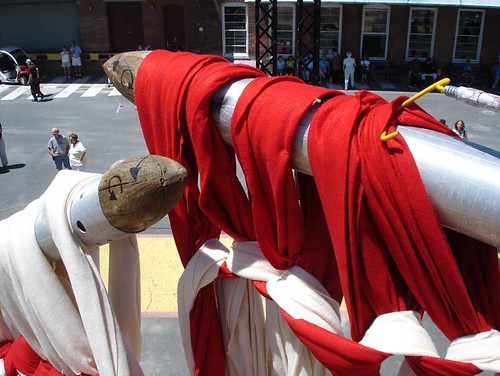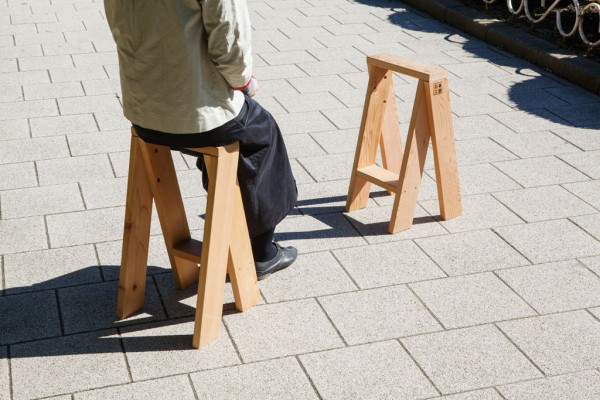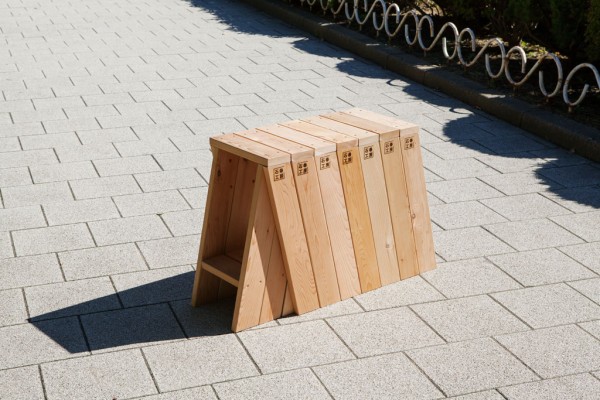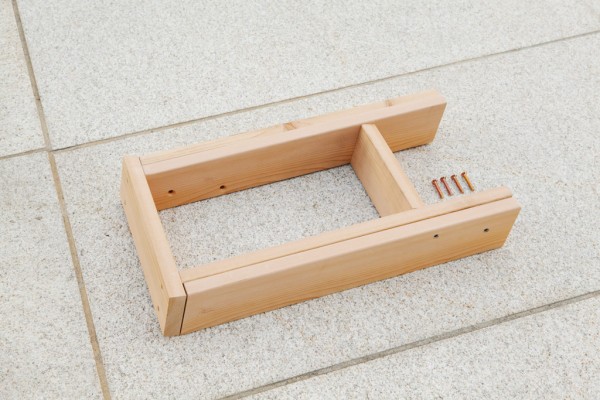Saturday, 24 November 2012
TEDxUCL| MARCOS CRUZ - LIVING BUILDINGS - ARCHITECTURE'S PATH TO ECOLOGY
Marcos Cruz is the Director of the Bartlett School of Architecture, UCL. His investigations about Neoplasmatic Architecture, which focused on a contemporary discussion about the body and the impact of bio-technology on architecture, won the RIBA President's Research Award for Outstanding PhD Thesis in 2008. Cruz's research concerns the different conceptions of flesh, the place of the body in architecture and our understanding of 'urbanism'. His research is dedicated to a future vision of the body in architecture, questioning our 'human flesh' and its altered relationship with a new contemporary 'architectural flesh'.
'Design through Production' | Bob Sheil
Bartlett International Lecture Series 2012/13 – Bob Sheil from Bartlett School of Architecture on Vimeo.
Professor Bob Sheil's inaugural lecture titled 'Design through Production' explored the illusive and evolving relationships between drawing and making in architecture through two decades of work by sixteen*(makers) and four edited books on associated fields. The lecture took place on 3rd October at The Bartlett School of Architecture as part of The Bartlett International Lecture Series.
Bio
Bob Sheil is Professor in Architecture and Design through Production at The Bartlett School of Architecture UCL, where he runs MArch Unit 23 with Emmanuel Vercruysse and Kate Davies, and is Director of Technology and Computing. He is a founding partner of sixteen*(makers), whose recent work in collaboration with Stahlbogen GmbH ‘55/02’ won a RIBA award for design. He has edited two editions of Architectural Design; ‘Design through Making’ (2005), and ‘Protoarchitecture’ (2008). In 2011 he Co-Chaired the highly successful international conference FABRICATE with Ruairi Glynn. In 2012 he published ‘Manufacturing the Bespoke’ an AD Reader on prototyping and making architecture in the digital age, and ‘55/02: A sixteen*(makers) Monograph’ (Riverside Architectural Press 2012). He is presently working on a new build project, and a third AD due for publication in January 2014
'Material Computation' | Achim Menges
Bartlett International Lecture Series 2012/13 – Achim Menges from Bartlett School of Architecture on Vimeo.
A video recording of the lecture given by Achim Menges entitled, 'Material Computation', as part of the Bartlett International Lecture Series on 31 October 2012.
Synopsis:
Computation, in its most basic meaning, refers to the processing of information. In this way, both machinic processes operating in the binary realm of the digital, as well as material processes operating in the complex domain of the physical can be considered computational. While there is a strong bias towards the former in contemporary design, sporadic investigations of the later have also occurred in architecture. What is more rarely explored, though, is the territory where machine computation and material computation potentially overlap, where they not simply co-exist but intensely interact in the design process.
The lecture will introduce Achim Menges’ work on computational design approaches that unfold morphological complexity and performative capacity without differentiating between form generation and materialisation processes. His design research, conducted at the Architectural Association, at Harvard University and at his new institute at Stuttgart University over the last ten years, will be presented along a series of constructed prototype buildings.
Biography:
Achim Menges, born 1975, is an architect and professor at Stuttgart University where he is the founding director of the Institute for Computational Design. In addition he has been Visiting Professor in Architecture at Harvard University’s Graduate School of Design. He graduated from the AA School of Architecture in London where he subsequently taught as Studio Master of the Emergent Technologies and Design Graduate Program from 2002 to 2009 and as Unit Master of Diploma Unit 4 from 2003 to 2006.
Achim Menges practice and research focuses on the development of integral design processes at the intersection of morphogenetic design computation, biomimetic engineering and computer aided manufacturing that enables a highly articulated, performative built environment. His work is based on an interdisciplinary approach in collaboration with structural engineers, computer scientists, material scientists and biologists. His projects and design research has received many international awards, has been published and exhibited worldwide, and form parts of numerous international museum collections.
achimmenges.net
'Power of Place' | Kengo Kuma
Bartlett International Lecture Series 2012/13 – Kengo Kuma from Bartlett School of Architecture on Vimeo.
A video recording of the lecture given by Kengo Kuma entitled, 'Power of Place', as part of the Bartlett International Lecture Series on 7 November 2012.
Synopsis:
It was always a natural disaster that directed the course of our civilizations, but the great disaster of 3.11 differed from any other catastrophes since the 1755 Lisbon Earthquake. Nature was desperately forceful as never before. However “strong” or “rational” the structures were, the tsunami flattened Tohoku coastline in seconds. The nuclear accident that followed further revealed the inability of “big and strong” architecture. In front of radiation, concrete or steel meant nothing, even though nuclear energy was a solution for our desire since the Lisbon tragedy, to become bigger, stronger, and more efficient. Now that such a process collapsed on itself, we have to start from scratch. Even before 3.11, I had already been fed up with massive concrete and steel buildings, and began to design a number of small works of architecture. You can build them on your own with nearby materials and be totally independent from strong powers – or rather, dependent solely on the nature, and power of the place. Now I sense that the whole world is shifting toward small things. We are no longer passive creatures who are spoon-fed from a giant yet unreliable system. Each individual starts to nest by him or herself and get energy on his or her own, taking advantage of their locality. A new relationship is being formed between people and the place.
Biography
Kengo Kuma was born in 1954. He completed his master’s degree at the University of Tokyo in 1979. From 1985 to 1986, he studied at Columbia University as Visiting Scholar. He established Kengo Kuma & Associates 1990. He taught at Keio University from 2001 to 2008, University of Illinois at Urbana-Champaign in 2008, and in 2009, he was installed as Professor at the Graduate School of Architecture, University of Tokyo.
Among Kuma’s major works are Kirosan Observatory (1995), Water/Glass (1995, received AIA Benedictus Award), Stage in Forest, Toyoma Center for Performance Arts (received 1997 Architectural Institute of Japan Annual Award), Stone Museum (received International Stone Architecture Award 2001), Bato-machi Hiroshige Museum (received The Murano Prize). Recent works include Great Bamboo Wall (2002, Beijing, China), Nezu Museum (2009, Tokyo), Yusuhara Marche and Wooden Bridge Museum (2010). A number of large projects are also going on abroad, including arts centre in Besancon City, France, Granada, Spain, and a new Victoria & Albert Museum building in Dundee, Scotland U.K..
He was awarded the International Spirit of Nature Wood Architecture Award in 2002 (Finland), International Architecture Awards for the Best New Global Design for “Chokkura Plaza and Shelter” in 2007, and Energy Performance + Architectutre Award in 2008 (France). He is an International Fellow of RIBA, UK, and Honorary Fellow of AIA in the US. Kengo Kuma is also a prolific writer / critic and his books have been translated into English, Chinese and other languages.
Plethora Project @jomasan | Rhino+Grasshopper ...
http://www.plethora-project.com
Plethora-Project.com is an initiative to accelerate computational literacy in the frame of architecture and design. It aligns with the "show me your screens" motto of the TopLap live-coding group attempting to get rid of Obscurantism in digital design.
Directed by Jose SanchezContact me at : jomasan@gmail.comBio:Jose Sanchez is an Architect / Programmer / Game Designer based in London. He is partner at Bloom Games, start-up built upon the BLOOM project, winner of the WONDER SERIES hosted by the City of London for the London 2012 Olympics. He is the director of the Plethora Project (www.plethora-project.com), a research and learning project investing in the future of on-line open-source knowledge. The project has over 100 videos and an open-source library of code that has been visited by over 200.000 people since it was founded in 2011. His background in computational design and digital manufacturing is linked to Biothing with Alisa Andrasek, were he was one of the principal designers in numerous projects and exhibitions since 2009. Today, he is a course studio Master at the MArch in Architectural Design at the Bartlett school of architecture, UCL in London. His studio ‘Gamescapes’, explores generative interfaces in the form of video games, speculating in modes of intelligence augmentation, combinatorics and open systems as a design medium.
RHINO MODELLING
RHINO MODELLING THE LF-ONE BY ZAHA HADID
TUTORIAL 01 – LOADING THE PLANS
TUTORIAL 02 – CURVES AND VOLUMES
TUTORIAL 03 – TRIM AND SPLIT
TUTORIAL 04 – CURVATURE AND DETAIL
TUTORIAL 05 – DETAILING FACADE
TUTORIAL 06 – DETAILING THE FLOOR
TUTORIAL 07 – INTERIOR
TUTORIAL 08 – DETAILING FACADE – 2
TUTORIAL 09 – CREATING A 2D DRAWING FILE FOR ILLUSTRATOR
TUTORIAL 10 – ADDITIONAL GEOMETRY
TUTORIAL 11 – EXTERIOR/INTERIOR TRANSITION
TUTORIAL 12 – INTERIOR BRIDGE
TUTORIAL 13 – DETAILING FOR THE SECTION
TUTORIAL 14 – MISSING BITS OF GEOMETRY
***DOWNLOAD PLANS, ELEVATIONS AND SECTIONS
*ADDITIONAL IMAGES
Plethora-Project.com is an initiative to accelerate computational literacy in the frame of architecture and design. It aligns with the "show me your screens" motto of the TopLap live-coding group attempting to get rid of Obscurantism in digital design.
Directed by Jose SanchezContact me at : jomasan@gmail.comBio:Jose Sanchez is an Architect / Programmer / Game Designer based in London. He is partner at Bloom Games, start-up built upon the BLOOM project, winner of the WONDER SERIES hosted by the City of London for the London 2012 Olympics. He is the director of the Plethora Project (www.plethora-project.com), a research and learning project investing in the future of on-line open-source knowledge. The project has over 100 videos and an open-source library of code that has been visited by over 200.000 people since it was founded in 2011. His background in computational design and digital manufacturing is linked to Biothing with Alisa Andrasek, were he was one of the principal designers in numerous projects and exhibitions since 2009. Today, he is a course studio Master at the MArch in Architectural Design at the Bartlett school of architecture, UCL in London. His studio ‘Gamescapes’, explores generative interfaces in the form of video games, speculating in modes of intelligence augmentation, combinatorics and open systems as a design medium.
RHINO MODELLING
RHINO MODELLING THE LF-ONE BY ZAHA HADID
TUTORIAL 01 – LOADING THE PLANS
TUTORIAL 02 – CURVES AND VOLUMES
TUTORIAL 03 – TRIM AND SPLIT
TUTORIAL 04 – CURVATURE AND DETAIL
TUTORIAL 05 – DETAILING FACADE
TUTORIAL 06 – DETAILING THE FLOOR
TUTORIAL 07 – INTERIOR
TUTORIAL 08 – DETAILING FACADE – 2
TUTORIAL 09 – CREATING A 2D DRAWING FILE FOR ILLUSTRATOR
TUTORIAL 10 – ADDITIONAL GEOMETRY
TUTORIAL 11 – EXTERIOR/INTERIOR TRANSITION
TUTORIAL 12 – INTERIOR BRIDGE
TUTORIAL 13 – DETAILING FOR THE SECTION
TUTORIAL 14 – MISSING BITS OF GEOMETRY
***DOWNLOAD PLANS, ELEVATIONS AND SECTIONS
*ADDITIONAL IMAGES
Grasshopper Tutorials:
TUTORIAL01 : INTRO
TUTORIAL02 : DATA MATCHING
TUTORIAL03 : LISTS AND SORT
TUTORIAL04 : CULL / DISPATCH
TUTORIAL05 : SHIFT LIST
TUTORIAL06 : SERIES / RANGE
TUTORIAL07 : GRAPH-MAPPER
TUTORIAL08 : FUNCTIONS AND ATTRACTORS
TUTORIAL09 : EXAMPLE 01
TUTORIAL10 : VECTORS 01
TUTORIAL11 : VECTORS 02
TUTORIAL12 : DATA TREES
TUTORIAL13 : VORONOI AND COLOR GRADIENTS
KANGOROO TUTORIAL 01 : INTRO
TUTORIAL01 : INTRO
TUTORIAL02 : DATA MATCHING
TUTORIAL03 : LISTS AND SORT
TUTORIAL04 : CULL / DISPATCH
TUTORIAL05 : SHIFT LIST
TUTORIAL06 : SERIES / RANGE
TUTORIAL07 : GRAPH-MAPPER
TUTORIAL08 : FUNCTIONS AND ATTRACTORS
TUTORIAL09 : EXAMPLE 01
TUTORIAL10 : VECTORS 01
TUTORIAL11 : VECTORS 02
TUTORIAL12 : DATA TREES
TUTORIAL13 : VORONOI AND COLOR GRADIENTS
KANGOROO TUTORIAL 01 : INTRO
Monday, 19 November 2012
Materials Blog Danish Design Centre
Interesting blog from the Danish Design Centre which U7 will visit in Copenhagen next week.
http://hellomaterialsblog.ddc.dk/
 |
| Materials and Manufacturing Education: Three Phases of Understanding | W. Ginn |
http://hellomaterialsblog.ddc.dk/
Thursday, 8 November 2012
Wednesday, 7 November 2012
Monday, 5 November 2012
U7 Visit to Grymsdyke Farm
Last friday U7 visited Grymsdyke Farm the wonderful workshop environments that are managed by architect, teacher and maker Guan Lee.
 |
| 3- axis CNC digital fabrication workshop with 3-d milling moulds |
 |
| Guan Lee and recently completed outdoor 'dining room' by Westminster Diploma Students |
Atelier One Visit U7
Chris Matthews and Luis Fernandez from Atelier One Engineers visited the U7 studio last week to present some of their current projects.
 |
| Luis presents the 'Super Tree' design | Gardens by the Bay | Singapore | World Building of the Year 2012 |
Sunday, 4 November 2012
Minimalistic Lightweight Construction: Temporary Pavilion in Noda
Architecture students from Tokyo developed an experimental, extremely lightweight, temporary pavilion structure – a tensegrity structure made of polyester membrane and aluminium struts. Two films give an impression of how the pavilion is set up.
Architects: Kazuhiro Kojima + Kojima Laboratory, Tokyo University of Science
Location: Tokyo University of Science, Noda Campus, Yamazaki, J-Noda
About 80% of the UV radiation is shielded off by the membrane, while 50% of daylight is transmitted, resulting in a fascinating interior atmosphere of soft filtered light. At night, the translucent pavilion turns into a light sculpture illuminated from the inside. After being used for seminars on the university campus for one week, the structure was disassembled and stored for next use.About 80% of the UV radiation is shielded off by the membrane, while 50% of daylight is transmitted, resulting in a fascinating interior atmosphere of soft filtered light. At night, the translucent pavilion turns into a light sculpture illuminated from the inside. After being used for seminars on the university campus for one week, the structure was disassembled and stored for next use.The pavilion was set up in a joint effort by 70 students in one day. After laying out the prefabricated elastic polyester fabric membrane, aluminium struts were inserted in special pockets in the fabric. The structure was then pushed upwards from the inside, while the struts around the edges were held down and finally fixed to the ground with pegs. The concave and convex shapes created form a moving surface – an elusive stage for a lively interplay of light and shade.
Architects: Kazuhiro Kojima + Kojima Laboratory, Tokyo University of Science
Location: Tokyo University of Science, Noda Campus, Yamazaki, J-Noda
About 80% of the UV radiation is shielded off by the membrane, while 50% of daylight is transmitted, resulting in a fascinating interior atmosphere of soft filtered light. At night, the translucent pavilion turns into a light sculpture illuminated from the inside. After being used for seminars on the university campus for one week, the structure was disassembled and stored for next use.About 80% of the UV radiation is shielded off by the membrane, while 50% of daylight is transmitted, resulting in a fascinating interior atmosphere of soft filtered light. At night, the translucent pavilion turns into a light sculpture illuminated from the inside. After being used for seminars on the university campus for one week, the structure was disassembled and stored for next use.The pavilion was set up in a joint effort by 70 students in one day. After laying out the prefabricated elastic polyester fabric membrane, aluminium struts were inserted in special pockets in the fabric. The structure was then pushed upwards from the inside, while the struts around the edges were held down and finally fixed to the ground with pegs. The concave and convex shapes created form a moving surface – an elusive stage for a lively interplay of light and shade.
Friday, 2 November 2012
KNITTING WITH CRANES

Finally. Knitting with cranes, by artist Dave Cole. Th knitting needles are telegraph poles with carved wooden tips, and are attached to two 'John Deere's, operated by humans.
Subscribe to:
Comments (Atom)












